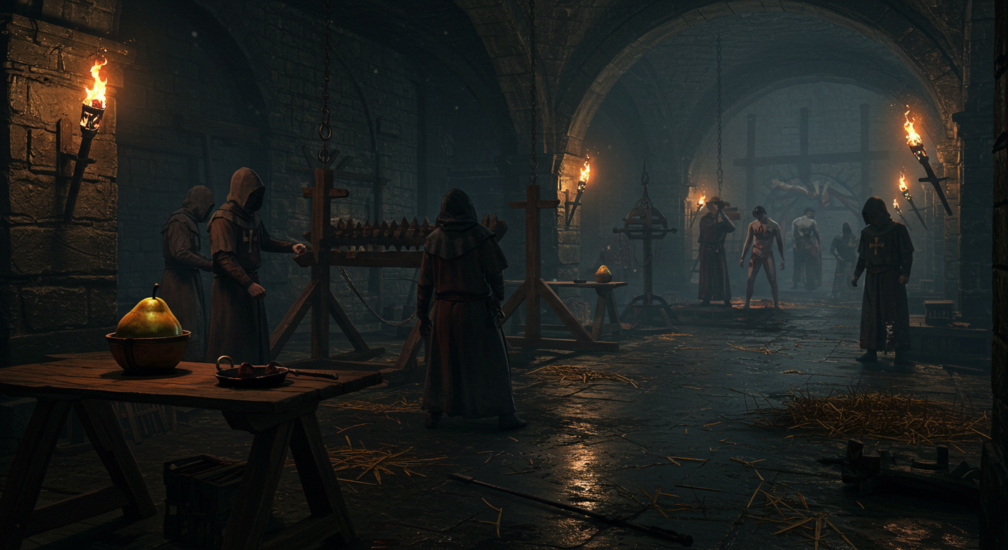The medieval period, a dark yet fascinating era, is renowned for its brutality, dread, and the terrifying cruelty inflicted upon those accused of crimes or dissent. Among the countless fears people faced, one of the most haunting was the risk of encountering gruesome medieval punishments. Torture and execution served not only as methods of justice but also as powerful demonstrations of power and tyranny.
Medieval Torture Devices: Instruments of Agony
Throughout medieval Europe, torturers wielded a terrifying array of medieval torture devices designed to prolong agony and maximize torment. Devices such as the infamous Rack stretched limbs beyond their natural limits, causing unimaginable anguish. The Iron Maiden, another chilling contraption, enclosed victims within an iron coffin lined with sharp spikes, inflicting horrific pain and inevitable death. Among the worst medieval torture devices was the Pear of Anguish, an apparatus inserted into various orifices and slowly expanded to tear flesh apart, epitomizing medieval brutality.
Medieval Execution Methods: Spectacles of Horror
Execution was a public spectacle, serving both as punishment and deterrence. Medieval execution methods often involved creative cruelty. Hanging, drawing, and quartering stands out as one of history’s worst punishments ever, combining hanging, disembowelment, and the mutilation of the condemned. Burning at the stake, another of the most savage execution methods, offered spectators a grotesque display of horror as victims succumbed painfully to flames.
Worst Torture Method in History
Determining the absolute worst torture method in history is challenging, as many medieval interrogation techniques aimed to extract confessions through extreme pain. However, breaking on the wheel frequently emerges as a leading candidate. Victims were strapped to a wheel, their bones systematically broken with iron rods. Left alive but immobile, their lingering torment was a chilling reminder of medieval cruelty.
Medieval Capital Punishment: Tyranny and Fear
Medieval capital punishment wasn’t merely about justice-it was an assertion of power through fear. Beheading, although swift, remained a public display of authority, while impalement, notoriously used by Vlad the Impaler, offered a prolonged death filled with dread and suffering. Such punishments solidified rulers’ absolute control, instilling horror within populations to suppress rebellion and maintain societal order.
Life in the Dungeon: Despair and Cruelty
Medieval dungeons epitomized despair, cruelty, and anguish. Prisoners endured cold, disease, starvation, and isolation, with many awaiting their execution in total darkness. Medieval interrogation techniques performed within dungeon walls ranged from thumb screws to branding irons, designed explicitly to maximize agony while extracting information-often regardless of truth.
Exploring the Dark Past Today
Today, the horrifying past of medieval torture lives on through various museums dedicated to preserving this grim chapter of history. The Medieval Torture Museum in Chicago vividly portrays the historical context and terror associated with these instruments of torment. Visitors seeking knowledge on gruesome medieval punishments and worst medieval torture devices will find these museums captivating and educational.
If you’re curious about further exploration, discover where to go in Los Angeles for another exceptional collection highlighting the dark ingenuity behind medieval capital punishment. Additionally, the Medieval Torture Museum in St Augustine offers a chilling journey into the heart of medieval brutality.
Delve Deeper into Medieval Torture History
Understanding the historical context behind these horrific practices provides insight into the evolution of human justice and cruelty. Our blog features detailed articles on medieval execution methods, individual stories of torment, and analyses of the psychological impacts behind the use of these grim tools.
By studying history’s worst ways to die in medieval times, we confront unsettling truths about humanity’s past inclinations toward tyranny and brutality. Reflecting on these dark episodes encourages us to appreciate the progress made and the ongoing necessity of human rights vigilance.
A Sobering Reflection
Examining medieval torture devices, worst punishments ever, and gruesome medieval punishments compels us to reflect on humanity’s darker capabilities. These savage practices, rooted in cruelty, dread, and the pursuit of power, remain stark reminders of our complex past. Understanding this history is vital, ensuring we never repeat the tragic errors that allowed such methods to flourish.
Visit one of the Medieval Torture Museums today to immerse yourself fully in these stories of historical torment, agony, and the persistent struggle against human cruelty.






